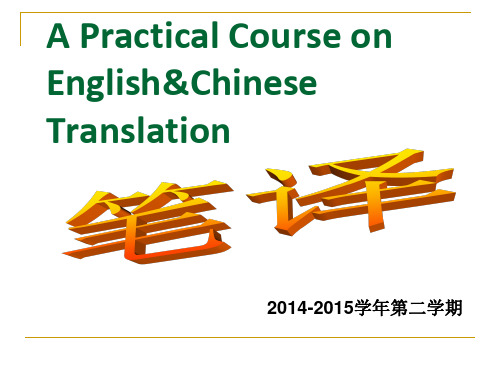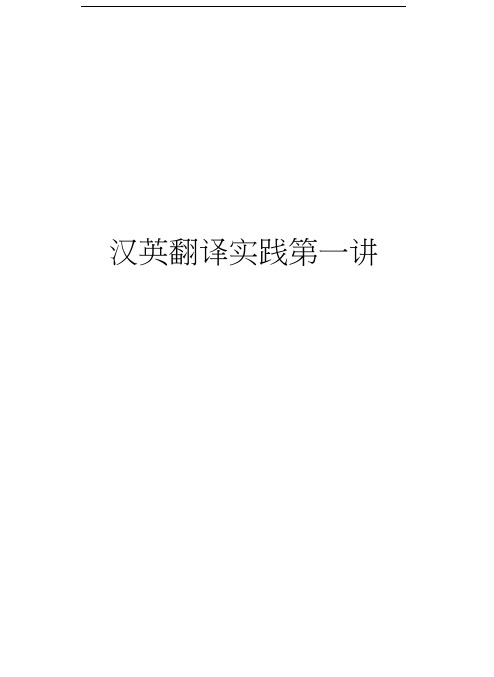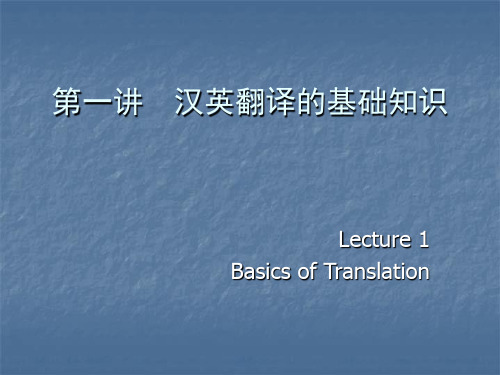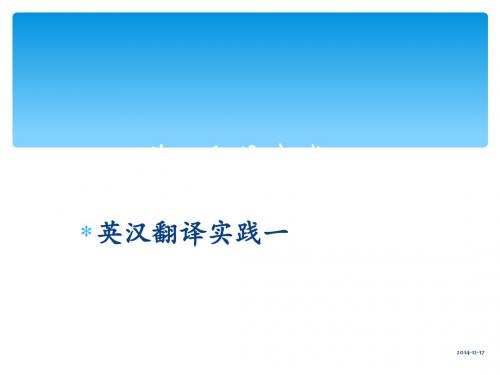汉英翻译实践第一讲
英汉翻译教程第一讲完整版.ppt

11. Constant dripping wears away a stone. 11.水滴石穿.
12. Creep before you walk.
12. 循序渐进。
13. Don't put the cart before the horse.
13. 不要本末倒置。
14. Don't trouble troubles until trouble troubles you.
11. Constant dripping wears away a stone. 12. Creep before you walk. 13. Don't put the cart before the horse. 14. Don't trouble trouble until trouble
境和风俗习惯的影响而具有不同的特点。 Drug : 药; 大麻(美俚)
1.2.5 社会政治
一些词语的意义,有时与社会政治密切相关。就 是说,社会制度相同,有关文化之间的差异就比 较少;社会制度不同, 差异就相对地多一些。如:
working class; peasant propaganda; Exploit (开发利用、获取利润) 汉语中是:“剥削”
1.2.6 文学艺术
文学艺术反映一个民族的感情色彩。 对待同一事物, 不同民族的文化感情色彩可能完全不同
Dragon, dog, ox
不同文化艺术中,人们还常常用不同的事物表达相 同的思想。
Work like a horse 像老黄牛一样干活。
As strong as a horse As stupid as a goose
Scope of translation
大学英语英汉翻译实践第一讲 课后作业部分

大学英语英汉翻译实践第一讲课后作业部分将下列段落译为汉语AttractionsManchester is a visitor's dream, bursting with interesting places to visit. Here, we list some of the city's leading attractions.Manchester is one of the most dynamic and lively places in Europe. A big city with a compact and friendly centre. A trendsetting music and style capital that still has a place for traditional street markets and local pubs. A place with an illustrious past that's always at the cutting edge of what's new.1.CulturalThe John Rylands LibraryRe-opened in May 2007 after a £16.8 million transformation, including improved access and visitor facilities, the John Rylands Library is definitely worth a visit. Experience the Gothic splendour of one of Manchester's most beautiful buildings and disco ver the library’s world famous collections through themed displays and hands-on activities. Enjoy a fascinating programme of exhibitions, talks and events throughout the year, relax in a brand new cafe and browse around the gift shop.2.Food and drinkCastlefieldBritain's first urban heritage park, Castlefield preserves Manchester's industrial legacy while offering visitors a picturesque canalside destination where they can eat, drink and have fun.Castlefield's mix of old and new is a winner with locals and visitors alike and its open spaces host festivals throughout the year.While the southern part of Castlefield is centred around water, the northern part is dominated by the Museum of Science and Industry in Manchester, another must-see attraction showcasing Manchester's industrial history.3.HistoryThe Imperial War MuseumDesigned by world-renowned architect Daniel Libeskind, the £28.5 million IWM North opened its doors in July 2002 and has since been blitzed with visitors.4.Art and cultureThe Lowry CentreRising like a futuristic ship at the heart of the redeveloped Salford Quays, The Lowry is a spectacular home to the arts and entertainment.5.ArtManchester Art GalleryRenowned for its prestigious collection of Pre-Raphaelite paintings, Manchester Art Gallery is one of the city's cultural gems.6.FootballOld TraffordMore than 200,000 people from all over the world visit Old Trafford every year to soak up the Manchester United experience and walk in the footsteps of George Best and the like.7.Historic houseTatton ParkIf the city gets a bit too much for you, escape to Tatton Park and take in its 1,000 acres of soothing scenery.8. Land's End Cornwall the most westerly point in mainland England. The most visited outdoor tourist attraction in the County. Lots for all the family to see and do. Land's End has rugged wave lashed cliffs, stunning views, the Longships Lighthouse and Wolf Rock off shore, the Isles of Scilly in the distance. 2500 miles away across the Atlantic Ocean is America. Land’s End.。
1-5:英汉互译实践与技巧 (课堂PPT)

《现代汉语词典》:“翻译是把一种语言文字的 意义用另一种语言文字表达出来。”
8
Ⅱ. Nature and Scope of Translation
翻译的性质和范围
Nature性质:
Translation is not a word for word activity
许建平 《英汉互译实践与技巧》清华大学出版社 2006年 郭著章、李庆生《英汉互译实用教程》武汉大学出版社
1996年 张培基 《英汉翻译教程》上海外语教育出版社 1980年 张光明 《英语实用文体翻译》中国科学技术大学出版社
2009年 连淑能 《英汉对比研究》高等教育出版社 1993年 李瑞华 《英汉语言文化对比研究》上海外语教育出版社
7
Ⅱ. Nature and Scope of Translation 翻译的性质和范围
英 国 翻 译 教 育 家 Peter Newmark : “ It is rendering the meaning of a text into another language in the way that the author intended the text. 翻译是按作者的创造意图把一篇文章的意思 用另一种语言描述出来的过程。”
2
实用文体翻译1:简历 实用文体翻译2:求职信 实用文体翻译3:通知 实用文体翻译4:致辞 实用文体翻译5:企业或学校简介 实用文体翻译6:六级英语 实用文体翻译7:考研英语 实用文体翻译8:新闻英语 实用文体翻译9:论文题目、摘要 实用文体翻译10:科技英语
3
Suggested reading books and websites
英汉互译理论和实践(共104张PPT)精选

“no-no” in today’s market place.此句 中的no-no词典(cídiǎn)上根本查不到,经 推敲,结果译为“无人问津”较为合适。 误译:织物整理剂在今日的市场无人问津。
4. Who keeps company with the wolf will learn to howl. 原译:近朱者赤,近墨者黑。
5. We’d like to express our appreciation to you for all you’ve done for us in the trade. 原译:我们对于你们在这笔交易中为我们所做的一切表示由衷的 感谢。
第十五页,共104页。
第十六页,共104页。
第十七页,共104页。
第二节 翻译(fānyì)标准
汉朝和唐朝——“文”与“质”之争。 主张“文”的翻译家强调翻译的修辞和
通顺(tōngshùn),强调翻译的可读性。 主张“质”的翻译家强调翻译的不增不
减,强调翻译中的忠实性。 该争论的实质是意译和直译之争。
第十八页,共104页。
清代翻译家严复 信(faithfulness); 达(expressiveness); 雅(elegance)。
他曾如此阐述“译事三难:信、达、雅。求 其信,已大难(dànán)矣!顾信矣,不达,虽 译,犹不译也,则达尚焉。”((《天演论》 (Evolution and Ethics and Other Essays)序 言,1896年)
第四页,共104页。
第五页,共104页。
1、简单(jiǎndān)语句的译文虽然生硬,但基本可读。 例2 原文:I can see three different types of
汉英翻译实践第一讲讲课讲稿

汉英翻译实践第一讲PART I:I. 原文(Source Text)水桥在巴拿马,有一座世界闻名的“水桥”,那就是巴拿马运河。
去年暑假,我跟着爸爸妈妈去巴拿马运河游览观光,至今还记忆犹新。
我们乘机抵达巴拿马城,然后搭上了一艘游轮,从巴尔博亚港进入运河。
船行13公里后,便到了运河的第一组水闸1。
巴拿马运河就是通过水闸的关与开,让船舰跨越陆地的一座“水桥” 2。
我们开始“上桥”了。
船驶进闸池之后,厚2米,高、宽各20米,重数百吨的钢闸门便缓缓地关闭,闸池里开始注水。
几分钟后,水涨船高3。
游轮在两岸电力机车的牵引下缓缓前进。
这样连升两级之后,船已经升高了16米。
出闸后,再驶过一个小湖,又到了第二组水闸。
经过这座水闸,船又升高了9.5米。
这样,船已高出海平面26米,进入“桥顶”4。
我们的游船驶进了长达13公里的主航道,只见5两岸山6如刀削,绿树红花,景色十分秀丽7。
游船出了峡谷,驶入了宽阔的加通湖。
湖水倒映着远山白云,美丽的小岛时隐时现8。
在湖中悠悠航行38公里之后,船来到了加通水闸,从此进入了“下桥”段。
这座水闸共有三级,犹如三个巨大的台阶。
游船经过加通水闸后,已经降到了与大西洋水面相同的高度。
当船驶入利蒙湾时,美丽的加勒比海便出现在眼前9。
我们从太平洋来到大西洋10,彼此隔离的大洋因为有了巴拿马运河而相通。
运河全长81.8公里,宽度由150米到304米不等。
5万吨级的巨轮,日夜畅通无阻。
它无愧于“世界桥梁”的称誉。
我由衷地赞美人类改造自然的智慧和勇气!我敬佩你,巴拿马人民!导游告诉我们,巴拿马人民是有志气的。
他们一方面正在改造现在这条运河;另一方面,还准备新建一条更长的运河,预计工程需要10年才能完成,它将成为人类有史以来最大的工程11。
我们期待着它早日完成。
II. 理解难点提示(Suggestions for Comprehension)1. 这里的“水闸”指什么?参考下文的“进闸池”、“出闸”。
汉英翻译第一讲课程介绍学习策略概要

严复
(1854-1921) 字几道,晚号愈野老人,别 号尊疑,又署天演哲学家。中国近代资产阶级 启蒙思想家、翻译家、教育家。1877年作为首 批海军留学生入英国皇家海军学院学习,在英 国期间除学习海军专业外,还精心研读西方哲 学、社会政治学著作,并到英国法庭考察审判 过程,作中西异同比较。
than she:
的这一身惨绿色的贞女的道服,
Be not her maid, since she is envious; 它是只配给愚人穿的。那是我
Her vestal livery is but sick and green 的意中人;啊!那是我的爱;
And none but foo》英文编译委员会委员,中共中央对外联络部
毛选英文编译定稿小组成员。长期致力于中国和西方文学的研究。
主张用比较文学、心理学、单位观念史学、风格学、哲理意义学
等多学科的方法,从多种角度理解和评价文学作品。著有散文集
《写在人生边上》,短篇小说集《人•兽•鬼》,长篇小说《围
城》,选本《宋诗选注》。文论集《七缀集》、《谈艺录》及
选》、《西厢记》、《红与黑》、《包法利夫人》、《追忆似水
年华》等众多名著。
作品初览
作品初览
傅雷
(1908-1966),一代翻译巨匠。早年留学法国, 学习艺术理论,得以观摩世界级艺术大师的作 品,大大地提高了艺术修养。回国后曾任教于 上海美专,因不愿从流俗而闭门译书,几乎译 遍法国重要作家如伏尔泰、巴尔扎克、罗曼•罗 兰的重要作品。数百万言的译作成了中国译界 备受推崇的范文,形成了“傅雷体华文语言”。 60年代以后,傅雷以其研究与翻译巴尔扎克著 作的卓越成就,被吸引为法国巴尔扎克研究协 会会员。他多艺兼通,在绘画、音乐、文学等 方面,均显示出独特的高超的艺术鉴赏力。 1957年被打成“右派”,但仍坚持自己的立场。 “文革”中因不堪忍受污辱,与夫人朱梅馥双 双含冤自尽,实现了文格与人格的统一。
翻译第一讲 翻译理论与实践

导学——学法指导 学法指导 导学
译者素养: 译者素养:
译者的素质: 译者的素质: 外语素质 语言敏感度 心理素质 翻译的辅助工具: 翻译的
导学——学法指导 学法指导 导学
Tips: :
提高方法: 提高方法:
翻译理论+翻译技巧+ 1. 翻译理论+翻译技巧+翻译实践 研究有关翻译的论述,弄懂翻译的基本问题。 ( 阅读理论著作;专题论文;翻译教材;译品的前言后语) 2. 研究译作范本 从中摸索翻译的规律和技巧,对比不同译本的处理和效果。 研究典型译例,注意翻译技巧的说明和译句的得失,为翻译 实践打好基础 3. 不断进行翻译实践 (1) 依照词语---句子---段落---语篇的顺序; (2) 选择不同题材和体裁的练习材料; (3) 难易循序渐进; (4) 译文反复修改,不断提高译文质量; (5) 选择有参考译文的文本,进行对比学习; (6) 可请别人修改或校正。
翻译理论与实践
导 学 第一章: 第一章:翻译概述 第二章: 第二章:英汉语言对比 第三章: 第三章:词语的翻译 第四章:句子翻译技巧( 第四章:句子翻译技巧(上) 第五章:句子翻译技巧( 第五章:句子翻译技巧(下) 第六章: 第六章:常见文体的翻译
导 学
• • 教学目的:本课程教学目的是使学生掌握基本的翻译理论,提高翻译水平。 教学目的:本课程教学目的是使学生掌握基本的翻译理论,提高翻译水平。 本课程主要介绍基本的翻译理论知识, 本课程主要介绍基本的翻译理论知识,通过英汉两种语言的对比和大量译例 翻译,介绍了翻译的一系列常用方法和技巧。通过实践熟悉翻译技巧, 翻译,介绍了翻译的一系列常用方法和技巧。通过实践熟悉翻译技巧,培养 翻译能力,不断提高翻译水平和能力。 翻译能力,不断提高翻译水平和能力。。
英汉翻译理论与实践Introduction

汉语: 主题显著的语言 (topic-prominent language), 采用主题述题(topic-comment) 的句式 “ 话语 --- 说明结构” 汉语句子建立在意念主轴 (thought-pivot) 上 英语: 主语显著的语言 (subject-prominent language), 几乎都 采用主语- 谓语(subject-predicate) 的句式 “ 主语 --- 谓语结构” 英语句子建立在形式( 或主谓) 主轴(form-pivot) 上
千山鸟飞绝,万径人踪灭。 孤舟蓑笠翁,独钓寒江雪。
Written by Liu Zong-yuan Translated by Qian Zhong-shu
钱钟书:化境说—理想 sublimed adaptation “文学翻译的最高标准是‘化’。把作品从一国文字转变成 另一国文字,既能不因语文习惯的差异而露出生硬牵强 的痕迹,又能完全保存原有的风味,那就算得入于‘化 境’。” 所谓“化境”,就是原作向译文的“投胎转世”,文字形 式虽然换了,而原文的思想、感情、风格、神韵都原原 本本地化到了译文的境界里了,丝毫不留下翻译的痕迹, 让读者读译作就完全像在读原作一样。
…on one sunny morning in June,… 六月的一天早上,天气晴朗…… Believe you can and you’re halfway there.— Theodore Roosevelt
10
Catford: The replacement of textural material in one language (SL) by equivalent textual material in another language.(TL). 奈达Nida: 所谓翻译,是指在译语中用最切近而又自然的 对等语再现原语的信息,首先在语义上,其次是文体上。 Translation consists in reproducing in the receptor language the closest natural equivalent of the source language message, first in terms of meaning and secondly in terms of style.
英汉翻译理论与实践PPT课件

改译:从这里望下去,整个山谷一览无遗,只见那田野、 河流和村庄,全都美不胜收,真叫我心驰神往。
不能逐字死译 All that glitters is not gold. 原译:所有光辉灿烂的都不是金子。 改译:所有光辉灿烂的并非都是金子。 He sleeps late. 原译:他睡得晚。 改译:他起得晚。 I shall not expect you until I see you. 原译:我不期待你直到我见到你。 改译:你随便什么时候来吧。
Translation consists in reproducing in the receptor language the closest natural equivalent of the source language message, first in terms of meaning and secondly in terms of style.
刘重德:信、达、切
faithfulness, expressiveness and closeness
傅雷:传神论/神似说
Transference of soul or spirit
“以效果而论,翻译应当像临画一样,所求的 不在形似而在神似。”
译文同原文在内容上一致,这叫“意似”,是 翻译的最低标准。译文同原文如果能在形式 上和精神上同时一致起来,或称“形似”和 “神似”,这是翻译的高标准。
贸易、文化、和平、人道等都离不开翻译,翻译在 历史上从未如此不可或缺……请大家试想一下,世 上一日无翻译会怎样……都将鸦雀无声。翻译工作 者就象电线中的电流,水管中的水流。
汉英翻技巧译第一讲词类转译法

we are against it, second, we are not afraid of it.
我们全体赞成他的建议。 We were all in favor of his suggestion. 我们不顾一切困难,挫折,坚持战斗。 They kept on fighting in spite of all
三.汉语动词转换成英语的介词或介词词组
与汉语相比,英语用介词较多,而且有一些英语 介词本是由动词演变而来的,具有动词的特征。 因此在汉译英时,汉语的一些动词常常可用英语 的介词或介词词组来翻译。如:
孩子们都上一个学堂。 The children are in the same school. 我们对待世界大战这个问题的态度是,第一,反
记住我永远支持你。 Remember that I am always with you. 那个家伙老是滔滔不绝讲个不停。 That fellow is very talkative. 他读书时不加选择。 He is indiscriminate in reading. 他们迫切地想弄到消息。 They were news-hungry. 你们现在得走了。 You must be off now.
演出已经开始了。 The Performance is on. 她非常漂亮。 She is a real beauty. 那个家伙笨得出奇。 That fellow is a typical fool.
在翻译实践中,要做到既忠实于原文又符 合译文语言规范,有时就需要适当改变一 些词类,即把原文中属于某种词类的词在 译文中转换成另一种词类。这就是翻译上 通常所说的“词类转换”。
汉英翻译讲义第1部分 汉英翻译的过程

汉英翻译讲义第一章汉英翻译的过程:正确理解——充分表达——校核翻译时译者要牢记:1. The meaning of a sign is determined by the meanings of other signs.2. Each word when used in a new context is a new word.3. Words have no meanings, and people have meanings for them.1.1正确理解(Correct Comprehension) 理解原文要对原文进行语言分析、语境分析和逻辑分析等1.扑克牌打烂了。
2. 他的衣服穿烂了。
3. 走一步看一步。
4. 我银行里为你挂个名,你白天去走走,晚上教教我儿子,一面找机会,好不好?《围城》5. 海上花园海上仙山6. 国际旅游年7. 汉语茶话会8. 世界风云9. 半边天10. 中国留学服务中心11. 经济半小时12. 此复印件与原件相符。
1.2 充分表达(Adequate Representation)13. 虽败犹荣14. 特快专递15. 真好玩儿!16. 招贴即撕17. 减肥法18.中央电视台对外广播节目19. 他的节目不理想。
译文1:Her performance is not ideal.译文2:Her performance is ____________________________________.译文3:Her performance is ____________________.20. 他的英文水平比我高。
译文1:His English level is higher than mine.译文2:He ____________________________ than I (do).译文3:He ____________________________in English than I (am).21. 这山望见那山高。
汉英翻技巧译第一讲词类转译法

三.汉语动词转换成英语的介词或介词词组
与汉语相比,英语用介词较多,而且有一些英语 介词本是由动词演变而来的,具有动词的特征。 因此在汉译英时,汉语的一些动词常常可用英语 的介词或介词词组来翻译。如: 孩子们都上一个学堂。 The children are in the same school. 我们对待世界大战这个问题的态度是,第一,反 对;第二,不怕。 Our attitude on the question of world war is , first, we are against it, second, we are not afraid of it.
在翻译实践中要做到既忠实于原文又符在翻译实践中要做到既忠实于原文又符合译文语言规范有时就需要适当改变一合译文语言规范有时就需要适当改变一些词类即把原文中属于某种词类的词在些词类即把原文中属于某种词类的词在译文中转换成另一种词类
汉英翻译技巧
第一章 词类转换法
第一章 词类转译法
一、汉语的动词转换成英语的名词 二、汉语的动词转换成英语的形容词 三、汉语的动词转换成英语的介词或介词 词组 四、汉语的形容词或副词转换成英语的名 词 五、汉语的名词转换成英语的动词
一.汉语的动词转换成英语的名词
汉语中动词用得较多,除大量的动宾结构 外,还有连动式、兼语式等两个以上动词 连用的现象。而英语则不然,一句话往往 只用一个谓语动词,而且英语的名词也比 汉语的名词用得多。由于两种语言各自所 具有的这种特点,汉译英时常常需要把汉 语动词转换成英语名词。有时,随着汉语 动词的这种转换,修饰该动词的副词也自 然需要转换。请看下列例句:
他们教导我们要珍惜每一个机会。 They taught us the value of an opportunity. 他长期以来习惯于在最后一分钟作出决定。 He has long been used to last-minute decisions. 她对他们越来越憎恨。 Her hatred for them grew more. 他酷爱古典音乐。 He is an ardent lover of classical music. 他指挥着一个团。 He is a commander of a regiment.
英汉翻译实践一

参考译文: 六招让你掌控自己的生活 让别人的情绪主宰自己的生活,你会懊恼吗? 你有自己的行事原则吗? 什么时候自我感觉最好?什么事情让你感受关怀 和幸福?活得自在,非得阳光、假日、海滩吗? 生活需要掌控。拥有自信,才能把握生活的节奏、 谱写自己的乐章、摆脱他人设定的生活基调。 找到适当的方法,以乐观的心态投入生活,给幸 福充满电,换一种方式,生活尽在自己掌握。
英汉翻译实践二
英汉翻译实践一
2014-12-17
Step 1: reading the following passage, what do you think it is talking about?
6 Simple Ways To Live Like No One’s Watching Are you guilty of letting other people's moods directly impact how you feel? Are the rules you live by your own? When do you feel best about yourself? What makes you feel loved or happy? Does it take a sunny vacation day on the beach for you to feel great? Take control of your life. Have confidence you will drum your own beat, hum to the tune of life playing in your head, and stop waiting for someone else to set the tone for your life. By identifying a few ways to tie positive emotions to your actions, you will super charge your happiness, transform your life, and take matters into your own hands. 2014-12-17
英汉翻译实践1

Unit 1I. 英汉翻译原理第一讲:什么是翻译?【例1】The history of a tree from the time it starts in the forest until the boards which it yields are used, would form an interesting and, in manyinstances, an exciting story.(“×”号表示译文有问题,下同)×树的历史开始于森林中,直到生产为木板后被使用为止,成为一个有趣且有许多事例的激动人心的故事。
上面这句话的原文实际上主要说了两点内容:1、树的历史的起迄时间2、树的历史是怎样一回事【译文】一棵树,从它在森林中生长起直到被制成木板使用为止,这段历史会构成一个饶有趣味的故事,在很多情况下这个故事十分激动人心。
【例2】There are two regulatory systems which interact. One timing system comes from the evidence of our senses and stomachs, and the periodicitywe experience when living in a particular time zone.×有两个调节系统相互作用。
一个定时系统来自于我们的感官和胃的证明,就是当我们生活在一个特定的时区所经历的周期性。
【译文】人体有两个相互作用的时间调节系统。
一个时间调节系统依据感官和胃发出的信息,依据我们生活在某个时区所体验的周期性规律。
寻找对等词语和结构然后将其串接成句的翻译方法,常表现如下:1、简单语句的译文虽然生硬,但基本可读。
如:【例3】I can see three different types of composers in musical history, each of whom creates music in a somewhat different fashion.×我能看到音乐史上有三种不同的作曲家,他们中每一个人以某种不同的方式创作音乐。
英汉翻译实践

Unit 1I. 英汉翻译原理第一讲:什么是翻译?【例1】The history of a tree from the time it starts in the forest until the boards which it yields are used, would form an interesting and, in manyinstances, an exciting story.(“×”号表示译文有问题,下同)×树的历史开始于森林中,直到生产为木板后被使用为止,成为一个有趣且有许多事例的激动人心的故事。
上面这句话的原文实际上主要说了两点内容:1、树的历史的起迄时间2、树的历史是怎样一回事【译文】一棵树,从它在森林中生长起直到被制成木板使用为止,这段历史会构成一个饶有趣味的故事,在很多情况下这个故事十分激动人心。
【例2】There are two regulatory systems which interact. One timing system comes from the evidence of our senses and stomachs, and the periodicitywe experience when living in a particular time zone.×有两个调节系统相互作用。
一个定时系统来自于我们的感官和胃的证明,就是当我们生活在一个特定的时区所经历的周期性。
【译文】人体有两个相互作用的时间调节系统。
一个时间调节系统依据感官和胃发出的信息,依据我们生活在某个时区所体验的周期性规律。
寻找对等词语和结构然后将其串接成句的翻译方法,常表现如下:1、简单语句的译文虽然生硬,但基本可读。
如:【例3】I can see three different types of composers in musical history, each of whom creates music in a somewhat different fashion.×我能看到音乐史上有三种不同的作曲家,他们中每一个人以某种不同的方式创作音乐。
第一讲 汉译英翻译过程及意义对等

过程和意义分类
八级汉译英大纲要求
能翻译相当于我国《人民日报》 能翻译相当于我国《人民日报》等报刊上各种文 章 题材包括: 1)日常生活记叙 2)一般政治、经济、文化方面的文章 3)文学作品 翻译速度为每小时250~300汉字 翻译速度为每小时250~300汉字 能运用汉译英的理论和技巧,翻译我国报刊杂志 上的论述文和国情介绍,以及一般文学作品的节 录 翻译速度为每小时250~300词 翻译速度为每小时250~300词
符号三角理论( the Semiotic Triangle) 符号三角理论( Triangle)
Thought or Reference (思想或所指关系)概念 Symbol 间接的联系 Referent (符号) (所指) 语言 客观世界
符号学的三分法
句法学(研究言内意义)研究符号与符号之间的关系 语义学(研究指称意义)研究符号与所指事物之间的关系 语用学(研究语用意义)研究符号与符号使用(者)之间 的关系 六、三类符号学意义 言内意义 词语成分之间、句子成分之间和篇章成分之间的 关系所反映的意义。它在语音、词汇、句子和篇章等层次 均有体现 指称意义(概念意义)词语、句子和篇章反映的客观世界 语用意义(蕴涵、联想、象征意义)语言符号与使用者的 关系,是语言符号对人产生的影响
语用意义
表征意义:话语中揭示发讯人身份及其地理、历史和阶级 背景、年龄、在交际中的态度等等的成份。 表达意义:语言符号的情感内容及其表达发讯人个性或个 人创造性的成份。 联想意义:语言符号唤起的联想以及它所暗示的、或者作 为它一部分的概念和印象。 祈使意义:发讯人企图改变收讯人行为或心态的意向,具 体表现为命令、敦促、说服或乞求。 社交意义:又叫“情境意义” 社交意义:又叫“情境意义”、“人际意义”,是语言符 人际意义” 号同建立、保持某种社会关系有关的方面。
01汉译英第一讲

Multi-point Perspective
。
汉英思维方式与语言差异(thinking patterns and language differences)
1.整体与个体(macrocosm vs. individuality) 2.悟性与理性(comprehension vs. rationality :汉语的模糊性(词性模糊、 语义模糊、语言单位模糊) 3.具象与抽象(concreteness vs. abstractness) 4.直觉与逻辑(intuition vs. logic)
(1)忠实:“忠实”指译文要忠实原文,准确表达其 思想,意义和文体风格。 例1:我的成功一半要归功于他。 译文1:Half of my success belonged to him. 译文2:I owed half of my success to him. 例2: 这台发动机出了毛病。 译文1:The generator has got some problems. 译文2:There is something wrong with the generator. 例3:啊!我不是诗人,我永远道不出我的爱,一种像 由音乐与图画所引起的爱。 译文1: Alas, I am not a poet! I shall never express my love, a love which is caused by music and painting. 译文2:Alas, I am not a poet! I shall never be able to express my love--- the kind of love as inspired by music and painting.
英汉汉英翻译实训教程Chapter One Introduction to Translation

[注]:美国当代翻译理论家尤金·奈达(Eugene Nida)提出的与 读者的反应对等的原则基本上也是以读者为取向。
ቤተ መጻሕፍቲ ባይዱ
General Introduction to Translation
英汉汉英翻译实训教程
直译与意译
Chapter One
• 这两种翻译原则流传到今天就是所谓的“直译”和“意译”说 ;
英汉汉英翻译实训教程
Chapter One
Translate another group of sentences to check your progress.
1. There I was at once surrounded by all the other patients. With curiosity in their eyes, they asked me all kinds of questions.
[译文]: 所有病号一下子把我围住了,问长问短,目光好奇。 2. She has many hot potatoes to handle every day.
[译文]: 她每天都要处理很多棘手的问题。 3. We missed him, but we wish him a long and happy retirement.
Every dog has its day. “每只狗都有它的日子。”
General Introduction to Translation
英汉汉英翻译实训教程
Chapter One
以译入语为取向的翻译原则
一味以译文读者的口味为准绳,完全是为了适合读 者的口味而让译文归化,有时甚至不惜曲解原作。
e.g.
Solomon “诸葛亮”
汉英翻译实践第一讲

PART I:I. 原文(Source Text)水桥在巴拿马,有一座世界闻名的“水桥”,那就是巴拿马运河。
去年暑假,我跟着爸爸妈妈去巴拿马运河游览观光,至今还记忆犹新。
我们乘机抵达巴拿马城,然后搭上了一艘游轮,从巴尔博亚港进入运河。
船行13公里后,便到了运河的第一组水闸1。
巴拿马运河就是通过水闸的关与开,让船舰跨越陆地的一座“水桥” 2。
我们开始“上桥”了。
船驶进闸池之后,厚2米,高、宽各20米,重数百吨的钢闸门便缓缓地关闭,闸池里开始注水。
几分钟后,水涨船高3。
游轮在两岸电力机车的牵引下缓缓前进。
这样连升两级之后,船已经升高了16米。
出闸后,再驶过一个小湖,又到了第二组水闸。
经过这座水闸,船又升高了9.5米。
这样,船已高出海平面26米,进入“桥顶” 4。
我们的游船驶进了长达13公里的主航道,只见5两岸山6如刀削,绿树红花,景色十分秀丽7。
游船出了峡谷,驶入了宽阔的加通湖。
湖水倒映着远山白云,美丽的小岛时隐时现8。
在湖中悠悠航行38公里之后,船来到了加通水闸,从此进入了“下桥”段。
这座水闸共有三级,犹如三个巨大的台阶。
游船经过加通水闸后,已经降到了与大西洋水面相同的高度。
当船驶入利蒙湾时,美丽的加勒比海便出现在眼前9。
我们从太平洋来到大西洋10,彼此隔离的大洋因为有了巴拿马运河而相通。
运河全长81.8公里,宽度由150米到304米不等。
5万吨级的巨轮,日夜畅通无阻。
它无愧于“世界桥梁”的称誉。
我由衷地赞美人类改造自然的智慧和勇气!我敬佩你,巴拿马人民!导游告诉我们,巴拿马人民是有志气的。
他们一方面正在改造现在这条运河;另一方面,还准备新建一条更长的运河,预计工程需要10年才能完成,它将成为人类有史以来最大的工程11。
我们期待着它早日完成。
II. 理解难点提示(Suggestions for Comprehension)1. 这里的“水闸”指什么?参考下文的“进闸池”、“出闸”。
2. 为什么称巴拿马运河为“水桥”?3.“涨、高”指“开始涨、高”,还是“涨、高”到了足够的高度?考虑上文的“几分钟后”。
- 1、下载文档前请自行甄别文档内容的完整性,平台不提供额外的编辑、内容补充、找答案等附加服务。
- 2、"仅部分预览"的文档,不可在线预览部分如存在完整性等问题,可反馈申请退款(可完整预览的文档不适用该条件!)。
- 3、如文档侵犯您的权益,请联系客服反馈,我们会尽快为您处理(人工客服工作时间:9:00-18:30)。
PART I:I. 原文(Source Text)水桥在巴拿马,有一座世界闻名的“水桥”,那就是巴拿马运河。
去年暑假,我跟着爸爸妈妈去巴拿马运河游览观光,至今还记忆犹新。
我们乘机抵达巴拿马城,然后搭上了一艘游轮,从巴尔博亚港进入运河。
船行13公里后,便到了运河的第一组水闸1。
巴拿马运河就是通过水闸的关与开,让船舰跨越陆地的一座“水桥”2。
我们开始“上桥”了。
船驶进闸池之后,厚2米,高、宽各20米,重数百吨的钢闸门便缓缓地关闭,闸池里开始注水。
几分钟后,水涨船高3。
游轮在两岸电力机车的牵引下缓缓前进。
这样连升两级之后,船已经升高了16米。
出闸后,再驶过一个小湖,又到了第二组水闸。
经过这座水闸,船又升高了9.5米。
这样,船已高出海平面26米,进入“桥顶”4。
我们的游船驶进了长达13公里的主航道,只见5两岸山6如刀削,绿树红花,景色十分秀丽7。
游船出了峡谷,驶入了宽阔的加通湖。
湖水倒映着远山白云,美丽的小岛时隐时现8。
在湖中悠悠航行38公里之后,船来到了加通水闸,从此进入了“下桥”段。
这座水闸共有三级,犹如三个巨大的台阶。
游船经过加通水闸后,已经降到了与大西洋水面相同的高度。
当船驶入利蒙湾时,美丽的加勒比海便出现在眼前9。
我们从太平洋来到大西洋10,彼此隔离的大洋因为有了巴拿马运河而相通。
运河全长81.8公里,宽度由150米到304米不等。
5万吨级的巨轮,日夜畅通无阻。
它无愧于“世界桥梁”的称誉。
我由衷地赞美人类改造自然的智慧和勇气!我敬佩你,巴拿马人民!导游告诉我们,巴拿马人民是有志气的。
他们一方面正在改造现在这条运河;另一方面,还准备新建一条更长的运河,预计工程需要10年才能完成,它将成为人类有史以来最大的工程11。
我们期待着它早日完成。
II. 理解难点提示(Suggestions for Comprehension)1. 这里的“水闸”指什么?参考下文的“进闸池”、“出闸”。
2. 为什么称巴拿马运河为“水桥”?3.“涨、高”指“开始涨、高”,还是“涨、高”到了足够的高度?考虑上文的“几分钟后”。
4. 这里两个分句是否平起平坐?考虑上文已经说过船“升高了16米,又升高了9.5米”。
5. “只见”是不是真的在描写“我们”在干什么?考虑上文的主语是“我们的游船”,不是“我们”;上文的宾语是“主航道”,下文接着是“两岸”。
6. “山”指hills还是指mountains?考虑1)上文说“桥顶”只高出海平面26米; 2)地理知识:巴拿马地峡很窄。
7. (我们的游船驶进了)“长达13公里的主航道,只见两岸山如刀削,绿树红花,景色十分秀丽”中各部分的层次关系如何?考虑“主航道”与“山”的空间关系,“山”与“绿树红花”的空间关系,“山”与“景色十分秀丽”的物与属性的关系。
8. 这里的“时隐时现”什么意思?参考1)上文的“驶入”,下文的“悠悠航行”;2)常识:“隐、现”可由光线明暗造成,遮拦物的有无造成,也可由观察者移动造成。
9. “驶入”与“出现”同时,还是先后?利用常识“运动是相对的”。
10.“我们从太平洋来到大西洋”发生了,正在发生,还是将发生?考虑1)上文说“加勒比海便出现在眼前”;2)地理知识:加勒比海是大西洋的一部分。
11. 这些话是不是作者的话?1)上文说“导游告诉我们”; 2)作文知识:“巴拿马人民是有志气的”是论点,而论点需要论据。
III. 译文(Target Text)A Water BridgeAcross1 Panama runs2 a world-famous “water bridge”, and3 that is the Panama Canal. Last summer vacation I went with my parents on a sightseeing tour along it, which4 is still fresh in my memory.Having got5to Panama City by air, we boarded a pleasure boat in the port of Balboa and sailed into the canal. The boat traveled 13 km and reached the first group of water locks. The Panama Canal is thus a “water bridge” that allows ships to cross land by the opening and closing of water locks.We began “getting onto the bridge”. When the boat had sailed into the lock chamber, the steel gate, 2 meters thick, 20 meters high and wide and hundreds of tons in weight, slowly closed, and water began running into the chamber, which continued for a few minutes6. The boat rose with the water and advanced slowly, pulled along by power cars along both banks. Two lifts like that raised the boat 16 meters7. It sailed out of the lock across a small lake and came to the second group of locks, which raised the boat another8 9.5 meters. In this way, the boat, now 26 meters above sea level, had got onto the “top of the bridge”. It sailed along the main channel, which stretched 13 km between beautiful hills as steep as if cut apart with a sword and covered with green trees and colorful flowers9.The boat sailed out of the gorge and into the wide Gatún Lake, with10 white clouds and distant hills reflected in it and pretty i sles passing into and out of sight11. After a leisurely journey of 38 km on the lake12, the boat came to the Gatún Locks, and there began its “descent down the bridge”. The Gatún Locks, three in number, looked like so many13 giganti c steps. After getting14 through the locks, the boat had descended to the same level as the surface of the Atlantic Ocean. The beautiful Caribbean Sea came into view as it15 sailed into the Limón Bay.We had come16 from the Pacific to the Atlantic, two great oceans separated by land but linked by the Panama Canal. The canal is 81.8 km in length and 150 to 304 m in width. Ships of 50,000 tons can pass it unimpeded all around the clock17. It is truly worthy of the name o f “the Bridge of the World”. Full of hearty praises18am I for man’s wisdom and courage in transforming nature! I admire you, the people of Panama!The guide told us that the Panamanian people had high aspirations. On the one hand, they were19 working to improve the existent canal, and on the other hand, they were planning for an even longer one, which20, it was estimated, would take 10 years to complete, and which21 would be the greatest project in man’s history. We look forward to its early completion22.IV. 表达讲解(Explanation of Expression)1. “在”译为across是由canal的形状与其同Panama的位置关系决定的。
这是具体化。
2. “有”译为runs,是由canal的形状决定的。
这也是具体化。
3. 原文中没有“和”(意合),译文里用and(形合)。
英语里不能单用逗号连接两个分句。
4. 原文没有主语,是承前省,译文用了which,既提供了主语,又与前面的分句连接起来了。
改为it或that只有前一种作用,没有后一种作用。
5. 原文的“我们”在全句之首,译文中句首没有we,条件是原文句首用非限定分句或无动词分句。
6. 原文“几分钟后”属下句,译文which continued for a few minutes属上句,但描写的是同一事实,只是观察角度不同(视点转换)。
